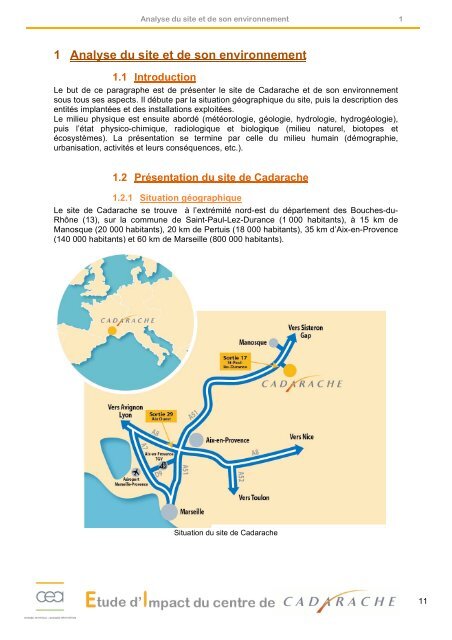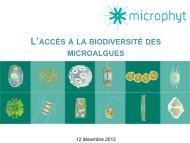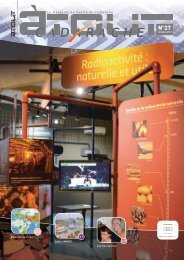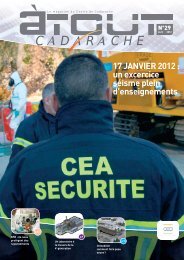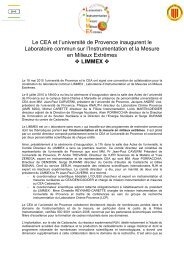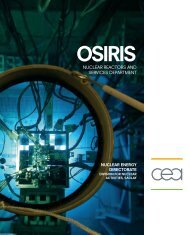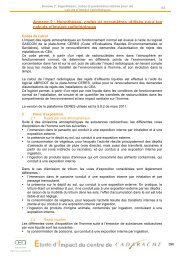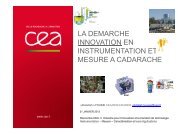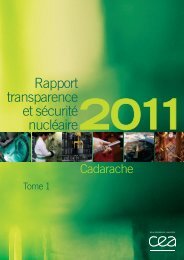1 Analyse du site et de son environnement - CEA Cadarache
1 Analyse du site et de son environnement - CEA Cadarache
1 Analyse du site et de son environnement - CEA Cadarache
- No tags were found...
You also want an ePaper? Increase the reach of your titles
YUMPU automatically turns print PDFs into web optimized ePapers that Google loves.
<strong>Analyse</strong> <strong>du</strong> <strong>site</strong> <strong>et</strong> <strong>de</strong> <strong>son</strong> <strong>environnement</strong> 11 <strong>Analyse</strong> <strong>du</strong> <strong>site</strong> <strong>et</strong> <strong>de</strong> <strong>son</strong> <strong>environnement</strong>1.1 Intro<strong>du</strong>ctionLe but <strong>de</strong> ce paragraphe est <strong>de</strong> présenter le <strong>site</strong> <strong>de</strong> <strong>Cadarache</strong> <strong>et</strong> <strong>de</strong> <strong>son</strong> <strong>environnement</strong>sous tous ses aspects. Il débute par la situation géographique <strong>du</strong> <strong>site</strong>, puis la <strong>de</strong>scription <strong>de</strong>sentités implantées <strong>et</strong> <strong>de</strong>s installations exploitées.Le milieu physique est ensuite abordé (météorologie, géologie, hydrologie, hydrogéologie),puis l’état physico-chimique, radiologique <strong>et</strong> biologique (milieu naturel, biotopes <strong>et</strong>écosystèmes). La présentation se termine par celle <strong>du</strong> milieu humain (démographie,urbanisation, activités <strong>et</strong> leurs conséquences, <strong>et</strong>c.).1.2 Présentation <strong>du</strong> <strong>site</strong> <strong>de</strong> <strong>Cadarache</strong>1.2.1 Situation géographiqueLe <strong>site</strong> <strong>de</strong> <strong>Cadarache</strong> se trouve à l’extrémité nord-est <strong>du</strong> département <strong>de</strong>s Bouches-<strong>du</strong>-Rhône (13), sur la commune <strong>de</strong> Saint-Paul-Lez-Durance (1 000 habitants), à 15 km <strong>de</strong>Manosque (20 000 habitants), 20 km <strong>de</strong> Pertuis (18 000 habitants), 35 km d’Aix-en-Provence(140 000 habitants) <strong>et</strong> 60 km <strong>de</strong> Marseille (800 000 habitants).Situation <strong>du</strong> <strong>site</strong> <strong>de</strong> <strong>Cadarache</strong>11
<strong>Analyse</strong> <strong>du</strong> <strong>site</strong> <strong>et</strong> <strong>de</strong> <strong>son</strong> <strong>environnement</strong> 1Carte <strong>du</strong> <strong>site</strong> <strong>de</strong> <strong>Cadarache</strong> (avec les clôtures) <strong>et</strong> <strong>de</strong> ses environsLe <strong>site</strong> se trouve près <strong>de</strong> la confluence <strong>de</strong> la Durance <strong>et</strong> <strong>du</strong> Verdon, à proximité <strong>de</strong>sdépartements <strong>de</strong>s Alpes-<strong>de</strong>-Haute-Provence, <strong>du</strong> Var <strong>et</strong> <strong>du</strong> Vaucluse. La commune <strong>de</strong> Saint-Paul-Lez-Durance est située à l’extrémité sud <strong>de</strong> la vallée <strong>de</strong> la moyenne Durance, peuavant un rétrécissement très marqué au niveau <strong>du</strong> défilé <strong>de</strong> Mirabeau.Le <strong>site</strong>, propriété <strong>du</strong> <strong>CEA</strong>, occupe une superficie totale <strong>de</strong> 1 780 hectares, dont 900hectares <strong>son</strong>t clôturés <strong>et</strong> regroupent les installations <strong>du</strong> <strong>CEA</strong> <strong>et</strong> <strong>de</strong> l’IRSN ; 180 hectarescontigus au nord-est <strong>son</strong>t également clôturés pour ITER.Le reste <strong>du</strong> <strong>site</strong> n’est pas clôturé ; il abrite notamment le château <strong>de</strong> <strong>Cadarache</strong> <strong>et</strong> les locaux<strong>de</strong> l’institut National <strong>de</strong>s Sciences <strong>et</strong> Techniques Nucléaires (INSTN).L’orientation principale est-ouest est parallèle à une p<strong>et</strong>ite vallée affluente <strong>de</strong> la Durance(Ravin <strong>de</strong> la Bête), le long <strong>de</strong> laquelle est implantée la majeure partie <strong>de</strong>s réacteursexpérimentaux <strong>du</strong> <strong>CEA</strong>.12
<strong>Analyse</strong> <strong>du</strong> <strong>site</strong> <strong>et</strong> <strong>de</strong> <strong>son</strong> <strong>environnement</strong> 1Plan <strong>du</strong> Centre <strong>de</strong> <strong>Cadarache</strong>Plan <strong>de</strong>s futures installations d’ITERLe reste <strong>du</strong> <strong>site</strong> consiste en une zone surplombant c<strong>et</strong>te vallée, moyennement inclinée versla Durance <strong>et</strong> s’étageant entre 250 <strong>et</strong> 400 mètres d’altitu<strong>de</strong>. Le terrain, relativementacci<strong>de</strong>nté, est en majeure partie couvert <strong>de</strong> forêts (bois domaniaux formés surtout d'espècesméditerranéennes).Le <strong>site</strong> est <strong>de</strong>sservi par la route départementale D 952, la nationale N 96 qui longe la rivedroite <strong>de</strong> la Durance <strong>et</strong> l’autoroute A 51, laquelle emprunte l’ancien lit <strong>de</strong> la Durance.13
<strong>Analyse</strong> <strong>du</strong> <strong>site</strong> <strong>et</strong> <strong>de</strong> <strong>son</strong> <strong>environnement</strong> 1Créée au sein <strong>du</strong> <strong>CEA</strong>, l’Agence ITER France est composée d’une vingtaine <strong>de</strong> spécialistesen charge <strong>de</strong> missions diverses :• gérer les travaux <strong>de</strong> viabilisation <strong>du</strong> <strong>site</strong> avant le démarrage <strong>de</strong>s travaux <strong>de</strong>construction <strong>de</strong> l’installation <strong>de</strong> recherche ;• accueillir les collaborateurs ITER <strong>et</strong> leurs familles ;• rassembler la contribution française (en argent <strong>et</strong> en nature) ;• élaborer les dossiers <strong>de</strong> sécurité <strong>et</strong> <strong>de</strong> sûr<strong>et</strong>é pour le compte d’ITER Organization ;• démanteler l’installation à la fin <strong>de</strong> <strong>son</strong> exploitation.L’agence ITER France est notamment exploitant d’ICPE sur le <strong>site</strong> d’ITER.1.2.2.4 IRSNL’IRSN est un établissement public à caractère in<strong>du</strong>striel <strong>et</strong>commercial placé sous la tutelle conjointe <strong>de</strong>s ministères chargés<strong>de</strong> l’écologie, <strong>de</strong> l’in<strong>du</strong>strie, <strong>de</strong> la recherche, <strong>de</strong> la défense <strong>et</strong> <strong>de</strong>la santé.Le champ <strong>de</strong> compétences <strong>de</strong> l'IRSN couvre l'ensemble <strong>de</strong>srisques liés aux rayonnements ionisants, utilisés dans l'in<strong>du</strong>strieou la mé<strong>de</strong>cine, ou encore les rayonnements naturels. Plusprécisément, l'IRSN exerce ses missions d'expertise <strong>et</strong> <strong>de</strong> recherche dans les domainessuivants :• surveillance radiologique <strong>de</strong> l’<strong>environnement</strong> <strong>et</strong> intervention en situation d’urgenceradiologique ;• radioprotection <strong>de</strong> l’homme ;• prévention <strong>de</strong>s acci<strong>de</strong>nts majeurs dans les installations nucléaires ;• sûr<strong>et</strong>é <strong>de</strong>s réacteurs ;• sûr<strong>et</strong>é <strong>de</strong>s usines, <strong>de</strong>s laboratoires, <strong>de</strong>s transports <strong>et</strong> <strong>de</strong>s déch<strong>et</strong>s ;• expertise nucléaire <strong>de</strong> défense.L’IRSN est notamment l’exploitant <strong>de</strong> quelques ICPE sur le <strong>site</strong> <strong>de</strong> <strong>Cadarache</strong>.1.2.3 Activités <strong>du</strong> <strong>site</strong> <strong>de</strong> <strong>Cadarache</strong>1.2.3.1 Le Centre <strong>de</strong> <strong>Cadarache</strong>Créé en 1959 <strong>et</strong> inauguré en 1963, le Centre <strong>CEA</strong> <strong>de</strong> <strong>Cadarache</strong> se consacre à <strong>de</strong>s activités<strong>de</strong> recherche expérimentale <strong>et</strong> <strong>de</strong> développement dans le domaine <strong>de</strong> l’énergie nucléaire <strong>de</strong>fission <strong>et</strong> <strong>de</strong> fusion, <strong>de</strong>s nouvelles technologies <strong>de</strong> l’énergie, <strong>de</strong> la biologie végétale <strong>et</strong> <strong>de</strong> lamicrobiologie.Le Centre accueille <strong>de</strong>s unités <strong>de</strong> la Direction <strong>de</strong> l’Energie Nucléaire (DEN), Direction <strong>de</strong> laRecherche Technologique (DRT), <strong>de</strong> la Direction <strong>de</strong>s Sciences <strong>de</strong> la Matière (DSM), <strong>de</strong> laDirection <strong>de</strong>s Sciences <strong>du</strong> Vivant (DSV) ainsi que <strong>de</strong> l’Institut <strong>de</strong>s Sciences <strong>et</strong> TechniquesNucléaires (INSTN).Des entreprises <strong>et</strong> organismes extérieurs <strong>son</strong>t également implantés à l’intérieur <strong>du</strong> Centre :Institut <strong>de</strong> Radioprotection <strong>et</strong> <strong>de</strong> Sûr<strong>et</strong>é Nucléaire (IRSN), AREVA NC, AREVA TA, STMI,AREVA NP.Les effectifs <strong>du</strong> Centre <strong>son</strong>t d’environ 2 100 salariés <strong>du</strong> <strong>CEA</strong> ; 1 000 salariés <strong>du</strong> GroupeAREVA <strong>et</strong> <strong>de</strong> l’IRSN ; 1 700 salariés permanents d’entreprises extérieures. A ces effectifss’ajoutent les 600 collaborateurs français <strong>et</strong> étrangers (doctorants, scientifiques français ouétrangers, stagiaires, intérimaires, <strong>et</strong>c.).Le Centre comprend 480 bâtiments, dont 20 Installations Nucléaires <strong>de</strong> Base (INB) <strong>et</strong> uneInstallation Nucléaire <strong>de</strong> Base secrète (INB-S) exploitées par le <strong>CEA</strong>. Les 39 InstallationsClassées pour la Protection <strong>de</strong> l’Environnement implantées sur le Centre <strong>son</strong>t exploitées soitpar le <strong>CEA</strong> (32 ICPE) soit par l’IRSN (7 ICPE).15
<strong>Analyse</strong> <strong>du</strong> <strong>site</strong> <strong>et</strong> <strong>de</strong> <strong>son</strong> <strong>environnement</strong> 11.2.3.2 ITERITER Organization emploie <strong>de</strong>s hommes <strong>et</strong> <strong>de</strong>s femmes venus d'une trentaine <strong>de</strong> pays pourtravailler ensemble dans le cadre <strong>du</strong> programme <strong>de</strong> coopération internationale ITER. Soneffectif, qui s'élevait à 500 per<strong>son</strong>nes fin 2010, <strong>de</strong>vrait atteindre les mille salariés <strong>du</strong>rant laphase opérationnelle d'ITER.Le chantier <strong>de</strong> construction <strong>du</strong> tokamak <strong>et</strong> <strong>de</strong>s bâtiments scientifiques a commencé en 2010.A terme ITER sera une installation nucléaire <strong>de</strong> base. A ce jour, l’agence ITER Franceexploite une ICPE sur le <strong>site</strong>.1.2.4 Description <strong>de</strong>s installations présentes sur le <strong>site</strong> <strong>de</strong><strong>Cadarache</strong>Les installations présentes sur le <strong>site</strong> <strong>de</strong> <strong>Cadarache</strong> <strong>son</strong>t décrites ci-après. Seules lesprincipales installations, notamment celles susceptibles d’avoir une inci<strong>de</strong>nce surl’<strong>environnement</strong> <strong>son</strong>t présentées afin <strong>de</strong> ne pas alourdir la présentation. Les Installationsnucléaires <strong>de</strong> base <strong>son</strong>t tout d’abord présentées, puis l’Installation nucléaire <strong>de</strong> basesecrète, ensuite les installations classées pour la protection <strong>de</strong> l’<strong>environnement</strong>, le chantierITER <strong>et</strong> enfin les installations non classées les plus notables.La présentation détaillée <strong>de</strong> chaque installation classée ainsi que ses rej<strong>et</strong>s figure enAnnexe 1.1.2.4.1 Présentation <strong>de</strong>s Installations nucléaires <strong>de</strong> base (INB)INB 22-PEGASE-CASCADExploitantDescriptionAutorisationRemarques<strong>CEA</strong>Installation d’entreposage sous eau <strong>de</strong> combustibles irradiés <strong>et</strong> à sec <strong>de</strong> fûts <strong>de</strong>sous-pro<strong>du</strong>its <strong>de</strong> fabrication d’éléments combustibles (PEGASE). Installationd'entreposage à sec <strong>de</strong> combustibles nucléaires irradiés (CASCAD)Décr<strong>et</strong> d’autorisation <strong>de</strong> création <strong>de</strong> Pégase <strong>du</strong> 17/04/1980 modifié par le décr<strong>et</strong>d’autorisation <strong>de</strong> création <strong>de</strong> CASCAD <strong>du</strong> 04/09/1989A l’origine l’installation Pégase avait pour vocation le test en vraie gran<strong>de</strong>urd’éléments combustibles <strong>de</strong> réacteurs refroidis au gaz. C<strong>et</strong>te fonction est àl’arrêt <strong>de</strong>puis le 19/12/1975INB 24- CABRIExploitantDescriptionAutorisationRemarques<strong>CEA</strong>Réacteur expérimental <strong>de</strong> type piscine à eau légère <strong>de</strong>stiné à l’étu<strong>de</strong> <strong>de</strong>scombustibles <strong>de</strong> réacteurs soumis à <strong>de</strong>s régimes acci<strong>de</strong>ntels ou inci<strong>de</strong>ntelsainsi qu’aux étu<strong>de</strong>s associées.Déclarée comme INB par l<strong>et</strong>tre SJC 64.590 <strong>du</strong> 27/05/1964, modifiée parLe décr<strong>et</strong> n°2006-320 <strong>du</strong> 20 mars 2006.L’installation est en cours <strong>de</strong> modification pour installer notamment une nouvelleboucle expérimentale qui perm<strong>et</strong>tra <strong>de</strong> tester avec une meilleurereprésentativité les éléments combustibles <strong>de</strong>s réacteurs à eau sous pression(réacteurs actuels <strong>du</strong> parc EDF).16
<strong>Analyse</strong> <strong>du</strong> <strong>site</strong> <strong>et</strong> <strong>de</strong> <strong>son</strong> <strong>environnement</strong> 1INB 25-RAPSODIE-LDACExploitantDescriptionAutorisationRemarques<strong>CEA</strong>Réacteur à neutrons rapi<strong>de</strong>s en démantèlement (RAPSODIE). Laboratoire <strong>de</strong>Découpage <strong>et</strong> d'Examens après irradiation <strong>de</strong>s Assemblages Combustibles endémantèlement (LDAC).RAPSODIE déclarée par l<strong>et</strong>tre SJC 64.590 <strong>du</strong> 27/05/1964. Autorisation <strong>de</strong> miseen exploitation LDAC : CSIA 66-226 <strong>du</strong> 20/12/1966.RAPSODIE est à l’arrêt <strong>de</strong>puis le 15/4/1983 <strong>et</strong> en cours d’assainissement. LeLDAC est à l’arrêt <strong>de</strong>puis 1997. A l’intérieur <strong>du</strong> périmètre <strong>de</strong> l’INB, <strong>de</strong>slaboratoires d’analyse restent en fonctionnement.INB 32-ATPuExploitantDescriptionAutorisationRemarques<strong>CEA</strong>, exploitant technique opérationnel AREVA-NC.Atelier <strong>de</strong> Technologie <strong>du</strong> Plutonium : fabrication <strong>de</strong> combustibles à based’oxy<strong>de</strong> mixte d’uranium <strong>et</strong> <strong>de</strong> plutonium (homogénéisation, pastillage, frittage,gainage).Déclarée comme INB par l<strong>et</strong>tre SJC 64.590 <strong>du</strong> 27/05/1964.Décr<strong>et</strong> <strong>de</strong> démantèlement n°2009-263 <strong>du</strong> 6 mars 2009.En fonction <strong>de</strong>puis 1962, l’ATPu a cessé toute activité commerciale en juill<strong>et</strong>2003 pour entrer dans une phase <strong>de</strong> traitement <strong>de</strong>s rebuts, <strong>de</strong>reconditionnement <strong>de</strong>s matières <strong>et</strong> d’assainissement. Il est entré en phase <strong>de</strong>démantèlement début 2009.INB 37-STEDExploitantDescription<strong>CEA</strong>La Station <strong>de</strong> Traitement <strong>de</strong>s Effluents <strong>et</strong> Déch<strong>et</strong>s est composée d’une Station<strong>de</strong> Traitement <strong>de</strong>s Effluents (STE) <strong>et</strong> d’une station <strong>de</strong> traitement <strong>de</strong>s déch<strong>et</strong>s(STD). La STE assure le traitement par évaporation <strong>de</strong>s effluents liqui<strong>de</strong>s suivi<strong>de</strong> l’enrobage <strong>de</strong>s concentrats dans une matrice en ciment. La STD traite <strong>et</strong>conditionne les déch<strong>et</strong>s soli<strong>de</strong>s.Autorisation Déclarée comme INB par l<strong>et</strong>tre SJC 64.590 <strong>du</strong> 27/05/1964.RemarquesL’installation AGATE remplacera à terme la STE.17
<strong>Analyse</strong> <strong>du</strong> <strong>site</strong> <strong>et</strong> <strong>de</strong> <strong>son</strong> <strong>environnement</strong> 1INB 39-MASURCAExploitantDescription<strong>CEA</strong>Réacteur d'essais maqu<strong>et</strong>te critique, où <strong>de</strong>s expériences <strong>de</strong> neutronique sur lescœurs <strong>de</strong> la filière <strong>de</strong>s réacteurs à neutrons rapi<strong>de</strong>s <strong>son</strong>t réalisées.Autorisation Décr<strong>et</strong> <strong>de</strong> création <strong>du</strong> 14/12/1966.INB 42-EOLEExploitantDescription<strong>CEA</strong>Réacteur d'essais, maqu<strong>et</strong>te critique <strong>de</strong> type piscine à eau lour<strong>de</strong> ou légère à<strong>de</strong>s fins d’étu<strong>de</strong>s neutroniques.Autorisation Décr<strong>et</strong> <strong>de</strong> création <strong>du</strong> 23/06/1965.Remarques Le réacteur se situe dans le même bâtiment que le réacteur MINERVE (INB 95).INB 52-ATUEExploitantDescriptionAutorisationRemarques<strong>CEA</strong>Atelier d'uranium enrichiAutorisation <strong>de</strong> création <strong>de</strong> 1962. Déclarée comme INB par l<strong>et</strong>tre SJC 68.036 <strong>du</strong>08/01/1968.Décr<strong>et</strong> <strong>de</strong> démantèlement n°2006-154 <strong>du</strong> 8 février 2006.Arrêt <strong>de</strong>s activités en 1995. Démantèlement en cours.18
<strong>Analyse</strong> <strong>du</strong> <strong>site</strong> <strong>et</strong> <strong>de</strong> <strong>son</strong> <strong>environnement</strong> 1INB 53-MCMFExploitantDescriptionAutorisationRemarques<strong>CEA</strong>Le Magasin Central <strong>de</strong> Matières Fissiles entrepose <strong>de</strong>s matières nucléaires nonirradiées, gère les flux <strong>de</strong> matières entre les Centres nucléaires, les Centres <strong>de</strong>pro<strong>du</strong>ction, les établissements in<strong>du</strong>striels nationaux <strong>et</strong> certains pays étrangers.Agrément <strong>de</strong> la CSIA pour la construction <strong>du</strong> bâtiment principal (62-54 <strong>du</strong>26/06/1962) <strong>et</strong> <strong>son</strong> extension (63-83 <strong>du</strong> 2/7/1963). Déclarée comme INB parl<strong>et</strong>tre SJC 68.036 <strong>du</strong> 08/01/1968.Les matières présentes dans le MCMF <strong>son</strong>t en cours <strong>de</strong> transfert versl’installation MAGENTA.INB 54-LPCExploitantDescriptionAutorisationRemarques<strong>CEA</strong>, exploitant technique opérationnel AREVA-NC.Le Laboratoire <strong>de</strong> Purification Chimique assure les opérations <strong>de</strong> contrôle <strong>de</strong>scombustibles fabriqués à l’ATPu ainsi que le suivi <strong>de</strong>s opérations <strong>de</strong> traitement<strong>de</strong>s rebuts.Déclarée comme INB par l<strong>et</strong>tre SJC 68.036 <strong>du</strong> 08/01/1968.Décr<strong>et</strong> <strong>de</strong> démantèlement n°2009-262 <strong>du</strong> 6 mars 2009.Mis en service en 1965, le LPC a cessé toute activité commerciale pour entrerdans une phase <strong>de</strong> traitement <strong>de</strong>s rebuts, <strong>de</strong> reconditionnement <strong>de</strong>s matières <strong>et</strong>d’assainissement. Il est entré en phase <strong>de</strong> démantèlement début 2009.INB 55-LECA-STARExploitantDescriptionAutorisation<strong>CEA</strong>Laboratoire d'Examen <strong>de</strong>s Combustibles Actifs (LECA) : examens <strong>de</strong>structifs <strong>et</strong>non <strong>de</strong>structifs sur <strong>de</strong>s éléments combustibles ainsi que sur <strong>de</strong>s matériauxfortement irradiés provenant <strong>de</strong> réacteurs expérimentaux <strong>et</strong> <strong>de</strong> réacteurs <strong>de</strong>sdifférentes filières nucléaires.Station <strong>de</strong> Traitement, d’Assainissement <strong>et</strong> <strong>de</strong> Reconditionnement <strong>de</strong>scombustibles irradiés (STAR) : stabilisation <strong>et</strong> reconditionnement avanttraitement <strong>de</strong>s éléments combustibles provenant <strong>de</strong> la filière uranium naturel –graphite – gaz.Autorisation d’exploitation <strong>du</strong> LECA par la CCSIA <strong>du</strong> 17/06/1964. LECA déclarécomme INB par l<strong>et</strong>tre SJC 68.036 <strong>du</strong> 08/01/1968. Décr<strong>et</strong> <strong>de</strong> création <strong>de</strong> STAR<strong>du</strong> 04/09/1989.19
<strong>Analyse</strong> <strong>du</strong> <strong>site</strong> <strong>et</strong> <strong>de</strong> <strong>son</strong> <strong>environnement</strong> 1INB 56-Parc d’entreposageExploitantDescriptionAutorisationRemarques<strong>CEA</strong>Entreposage en surface <strong>de</strong> déch<strong>et</strong>s soli<strong>de</strong>s en attente d’évacuation (hangars <strong>et</strong>fosses). Entreposage en piscine <strong>de</strong> combustibles irradiés expérimentaux entransit. Entreposage en tranchées <strong>de</strong> déch<strong>et</strong>s radioactifs pro<strong>du</strong>its par lesinstallations <strong>du</strong> Centre.Déclarée comme INB par l<strong>et</strong>tre SJC 68.036 <strong>du</strong> 08/01/1968. Autorisation <strong>de</strong> miseen service <strong>de</strong>s tranchées en 1969.Tranchées exploitées <strong>de</strong> 1969 à 1974, en cours d’assainissement.INB 92-PHEBUSExploitantDescriptionAutorisation<strong>CEA</strong>Réacteur d'essais <strong>de</strong> type piscine à barreaux d’oxy<strong>de</strong> d’uranium faiblementenrichi. De fonctionnement intermittent, l’installation est un outil pour l’étu<strong>de</strong> <strong>de</strong>shypothèses d’acci<strong>de</strong>nt pouvant affecter un réacteur à eau sous pression.Extension PF : installation <strong>de</strong> simulation <strong>du</strong> comportement <strong>et</strong> <strong>du</strong> transport <strong>de</strong>spro<strong>du</strong>its <strong>de</strong> fission (PF) dans une installation en cas <strong>de</strong> fusion <strong>du</strong> cœur.Décr<strong>et</strong> <strong>de</strong> création N° 77-801 <strong>du</strong> 05/07/1977. Décr<strong>et</strong> <strong>de</strong> modification <strong>de</strong> Phébuspour la réalisation <strong>de</strong>s programmes PF N° 91-1154 <strong>du</strong> 07/11/1991.INB 95-MINERVEExploitant<strong>CEA</strong>DescriptionRéacteur d'essais, maqu<strong>et</strong>te critique <strong>de</strong> type piscine.Autorisation Décr<strong>et</strong> <strong>de</strong> création n°77-1072 <strong>du</strong> 21/09/1977.Remarques Le réacteur se situe dans le même bâtiment que le réacteur EOLE (INB 42).20
<strong>Analyse</strong> <strong>du</strong> <strong>site</strong> <strong>et</strong> <strong>de</strong> <strong>son</strong> <strong>environnement</strong> 1INB 123-LEFCAExploitant<strong>CEA</strong>DescriptionLaboratoire d'Etu<strong>de</strong>s <strong>et</strong> <strong>de</strong> Fabrication expérimentales <strong>de</strong> Combustiblesnucléaires Avancés : étu<strong>de</strong>s sur le plutonium, l’uranium, les actini<strong>de</strong>s <strong>et</strong> leurscomposés sous toutes leurs formes (alliages, céramiques, compo<strong>site</strong>s) en vue<strong>de</strong> leur application aux réacteurs nucléaires.Autorisation Décr<strong>et</strong> <strong>de</strong> création <strong>du</strong> 23/12/1981.INB 156-CHICADEExploitant<strong>CEA</strong>DescriptionLaboratoire <strong>de</strong> recherche <strong>et</strong> développement sur les déch<strong>et</strong>s nucléaires :traitement <strong>de</strong> déch<strong>et</strong>s liqui<strong>de</strong>s aqueux, décontamination, conditionnement <strong>de</strong>sdéch<strong>et</strong>s soli<strong>de</strong>s, expertise <strong>et</strong> contrôle <strong>de</strong> colis <strong>de</strong> déch<strong>et</strong>s conditionnés.Autorisation Décr<strong>et</strong> <strong>de</strong> création <strong>du</strong> 29/03/1993INB 164 CEDRAExploitantDescription<strong>CEA</strong>Traitement <strong>et</strong> entreposage <strong>de</strong> déch<strong>et</strong>s radioactifs faiblement <strong>et</strong> moyennementradioactifs.Autorisation Décr<strong>et</strong> <strong>de</strong> création n°2004-1043 <strong>du</strong> 4/10/2004.21
<strong>Analyse</strong> <strong>du</strong> <strong>site</strong> <strong>et</strong> <strong>de</strong> <strong>son</strong> <strong>environnement</strong> 1INB 169 MAGENTAExploitantDescription<strong>CEA</strong>Caractérisation, conservation <strong>et</strong> conditionnement <strong>de</strong>s matières nucléaires.Autorisation Décr<strong>et</strong> <strong>de</strong> création n°2008-1004 <strong>du</strong> 25/09/2008.RemarquesRemplace l’INB 53 (MCMF), l’installation est en cours <strong>de</strong> remplissage.INB 171 AGATEExploitantDescription<strong>CEA</strong>Traitement <strong>de</strong>s effluents liqui<strong>de</strong>s radioactifs (concentration par évaporation).Autorisation Décr<strong>et</strong> <strong>de</strong> création n°2009-332 <strong>du</strong> 25/03/2009.Remarques A sa mise en service prévue en 2012, AGATE remplacera la STE <strong>de</strong> l’INB 37.INB 172 RJHExploitantDescription<strong>CEA</strong>Réacteur d’irradiation à haut flux <strong>de</strong> neutrons.Autorisation Décr<strong>et</strong> <strong>de</strong> création n°2009-1219 <strong>du</strong> 12/10/2009.RemarquesProj<strong>et</strong> en partenariat national <strong>et</strong> international. Le RJH est amené à prendre lerelais <strong>du</strong> réacteur OSIRIS <strong>de</strong> Saclay. Mise en service prévue en 2016.22
<strong>Analyse</strong> <strong>du</strong> <strong>site</strong> <strong>et</strong> <strong>de</strong> <strong>son</strong> <strong>environnement</strong> 11.2.4.2 Description <strong>de</strong> l’Installation nucléaire <strong>de</strong> base secrète (INB-S)La zone où se trouvent les installations décrites dans le présent chapitre est appelée INBS-PN (Installation Nucléaire <strong>de</strong> Base Secrète pour la Propulsion Navale) est soumise à <strong>de</strong>srègles <strong>de</strong> protection <strong>du</strong> secr<strong>et</strong> <strong>de</strong> Défense Nationale. La modification <strong>de</strong> c<strong>et</strong>te zone pour yintégrer le RES a été autorisée par Décr<strong>et</strong> <strong>du</strong> 31/07/03. La zone INB-S comprend lesinstallations présentées ci-après.RNGExploitantDescriptionAutorisationRemarques<strong>CEA</strong>, exploitant technique opérationnel AREVA-TA.Réacteur Nouvelle Génération, le RNG est une transformation <strong>de</strong> la CAP(Chaufferie Avancée Prototype), ancienne INB 82.Autorisation <strong>de</strong> chargement <strong>du</strong> RNG donnée le 09/06/1989 par CCSIA/89-174.Ce réacteur a permis <strong>de</strong> qualifier les innovations technologiques <strong>de</strong>s réacteursnucléaires <strong>de</strong> propulsion navale <strong>et</strong> <strong>de</strong> former les équipages <strong>de</strong> la Marinenationale,Arrêt définitif en octobre 2005 mais un certain nombre d’équipements <strong>et</strong> <strong>de</strong>systèmes <strong>son</strong>t encore en activité.PATExploitantDescription<strong>CEA</strong>, exploitant technique opérationnel AREVA-TA.Prototype à terre.Autorisation Autorisation définitive CSIA/65-135 <strong>du</strong> 28/01/1965.RemarquesPremier réacteur <strong>de</strong> qualification <strong>et</strong> d’entraînement <strong>du</strong> programme nucléairenaval pour la Marine Nationale. Mis en service en 1964. Mise à l’arrêt définitif en1992.23
<strong>Analyse</strong> <strong>du</strong> <strong>site</strong> <strong>et</strong> <strong>de</strong> <strong>son</strong> <strong>environnement</strong> 1AZURExploitantDescription<strong>CEA</strong>, exploitant technique opérationnel AREVA-TA.Réacteur « pile critique » qui perm<strong>et</strong> <strong>de</strong> tester les cœurs neufs <strong>de</strong>s réacteursnucléaires <strong>de</strong> propulsion navale.Autorisation Autorisation <strong>de</strong> construction donnée par décision 61-29 <strong>du</strong> 27/06/1961.FSMCExploitantDescriptionAutorisation<strong>CEA</strong>, exploitant technique opérationnel AREVA-TA.Fabrication, Stockage <strong>et</strong> Manutention <strong>de</strong> Combustible : le FSMC perm<strong>et</strong> l’étu<strong>de</strong><strong>et</strong> la fabrication <strong>de</strong>s combustibles nucléaires utilisés par la Marine Nationale.Autorisation <strong>de</strong> construction donnée par la décision HC/CD 80-300 <strong>du</strong> 4/12/1980.Autorisation <strong>de</strong> poursuite d'exploitation HC/00-343 DDSN/00-259 <strong>du</strong> 18/10/2000.RESExploitantDescription<strong>CEA</strong>, exploitant technique opérationnel AREVA-TA.Réacteur expérimental d’essais.Autorisation Autorisation <strong>de</strong> construction donnée par décision HC/99-372 <strong>du</strong> 02/08/99.RemarquesLe RES est composé d’une partie piscine <strong>et</strong> d’une partie réacteur. L’installationRES piscine perm<strong>et</strong>tant l’entreposage <strong>et</strong> l’examen <strong>de</strong>s combustibles irradiés, esten exploitation <strong>de</strong>puis octobre 2005. A terme, le RES remplacera le RNG.1.2.4.3 Description <strong>de</strong>s Installations classées pour la protection <strong>de</strong> l’<strong>environnement</strong>Certaines installations <strong>du</strong> <strong>site</strong> <strong>de</strong> <strong>Cadarache</strong> relèvent <strong>de</strong> la nomenclature <strong>de</strong>s InstallationsClassées pour la Protection <strong>de</strong> l’Environnement (ICPE) <strong>du</strong> fait <strong>de</strong>s équipements implantés(groupes froids, batteries, <strong>et</strong>c.) ainsi que <strong>de</strong>s pro<strong>du</strong>its <strong>et</strong> substances stockés <strong>et</strong> manipulés(sources nucléaires, fioul, pro<strong>du</strong>its chimiques dangereux, <strong>et</strong>c.). Elles peuvent être àcaractère nucléaire ou non nucléaire. Les installations <strong>son</strong>t présentées dans l’ordre <strong>de</strong>l’arrêté préfectoral <strong>du</strong> 25 septembre 2006 (ICPE <strong>CEA</strong>), puis celui <strong>du</strong> 12 Août 2005 relatif auxICPE <strong>de</strong> l’IRSN <strong>et</strong> enfin celui <strong>du</strong> 1 er décembre 2009 pour ITER.24
<strong>Analyse</strong> <strong>du</strong> <strong>site</strong> <strong>et</strong> <strong>de</strong> <strong>son</strong> <strong>environnement</strong> 1Bâtiment 100ExploitantType ICPEDescription<strong>CEA</strong>DéclarationLe bâtiment 100, à usage <strong>de</strong> bureaux, contient un atelier <strong>de</strong> charged’accumulateurs pour la téléphonie <strong>et</strong> l’informatique <strong>du</strong> Centre.Bâtiment 151AExploitantType ICPEDescription<strong>CEA</strong>DéclarationLe bâtiment 151A accueille <strong>de</strong>s serveurs informatiques, ainsi que leurs moyens<strong>de</strong> réfrigération (groupes froids) <strong>et</strong> <strong>de</strong>s chargeurs d’accumulateurs.Bâtiment 151BExploitantType ICPEDescription<strong>CEA</strong>DéclarationLe bâtiment 151B, salle polyvalente, contient 2 groupes froids pour laclimatisation <strong>de</strong> la salle.25
<strong>Analyse</strong> <strong>du</strong> <strong>site</strong> <strong>et</strong> <strong>de</strong> <strong>son</strong> <strong>environnement</strong> 1Laboratoire UO2(bâtiment 315)ExploitantType ICPEDescription<strong>CEA</strong>AutorisationRecherche <strong>et</strong> développement pour la fabrication <strong>de</strong> combustibles à base d’oxy<strong>de</strong>d’uranium ou <strong>de</strong> thorium.MMB(bâtiment 411)ExploitantType ICPEDescription<strong>CEA</strong>AutorisationMagasin <strong>de</strong>s matières brutes : entreposage d'uranium naturel ou appauvri, <strong>de</strong>sfûts <strong>de</strong> thorium <strong>et</strong> <strong>de</strong>s fûts <strong>de</strong> matières radioactives pouvant contenir <strong>du</strong> thorium,<strong>de</strong> l'uranium naturel, <strong>de</strong> l'uranium faiblement enrichi.PLINIUS(bâtiment 281)ExploitantType ICPEDescription<strong>CEA</strong>DéclarationLa plateforme PLINIUS a pour vocation l’étu<strong>de</strong> <strong>du</strong> corium(magma issu <strong>de</strong> la fusion <strong>du</strong> cœur d’un réacteur nucléaire) <strong>et</strong><strong>de</strong>s dispositions pour le gérer.Radionucléi<strong>de</strong>s à vie longue(bâtiment 307)Exploitant<strong>CEA</strong>Type ICPEDescriptionAutorisationAtelier en cessation d’activité <strong>de</strong>puis 2004, en cours d’assainissement.RHODIA(bâtiments 420-465)30
<strong>Analyse</strong> <strong>du</strong> <strong>site</strong> <strong>et</strong> <strong>de</strong> <strong>son</strong> <strong>environnement</strong> 1Type ICPEDescriptionAutorisationDispositif expérimental perm<strong>et</strong>tant l'étu<strong>de</strong> physique <strong>de</strong>s plasmaschauds, <strong>de</strong>nses <strong>et</strong> confinés magnétiquement.TOTEM(bâtiment 224)ExploitantType ICPEDescription<strong>CEA</strong>AutorisationRecherche <strong>et</strong> développement sur le comportement <strong>de</strong>s éléments constitutifs <strong>de</strong>sréacteurs, développement <strong>de</strong> nouvelles métho<strong>de</strong>s <strong>de</strong> caractérisation <strong>de</strong>sdéch<strong>et</strong>s.La Roton<strong>de</strong>(bâtiment 801)ExploitantType ICPEDescription<strong>CEA</strong>AutorisationPlateforme logistique pour la gestion <strong>et</strong> le contrôle <strong>de</strong>s déch<strong>et</strong>s radioactifs <strong>de</strong>faible <strong>et</strong> très faible activité.166(bâtiments 166, 172 <strong>et</strong> 173)ExploitantType ICPEDescriptionIRSNDéclarationRéalisation d’étu<strong>de</strong>s <strong>et</strong> <strong>de</strong> recherches en laboratoire sur les mécanismes d<strong>et</strong>ransport <strong>et</strong> <strong>de</strong> transfert <strong>de</strong>s radionucléi<strong>de</strong>s dans les écosystèmes.186(bâtiments 186 <strong>et</strong> 187)ExploitantType ICPEIRSNAutorisation33
<strong>Analyse</strong> <strong>du</strong> <strong>site</strong> <strong>et</strong> <strong>de</strong> <strong>son</strong> <strong>environnement</strong> 1DescriptionLaboratoire d’expérimentation sur <strong>de</strong>s composantes <strong>de</strong> l’<strong>environnement</strong> (sols <strong>et</strong>matériels biologiques) pour l’étu<strong>de</strong> <strong>de</strong>s transferts dans l’<strong>environnement</strong>.CEZANNE-AMANDE(bâtiments 422 <strong>et</strong> 468)ExploitantType ICPEDescriptionIRSNAutorisationPro<strong>du</strong>ction <strong>de</strong> neutrons pour <strong>de</strong>s activités <strong>de</strong> recherche <strong>et</strong> d’expertise endosimétrie <strong>et</strong> en métrologie <strong>de</strong>s neutrons.EPICUR(bâtiments 327)ExploitantType ICPEDescriptionIRSNAutorisationEtu<strong>de</strong>s relatives à la chimie <strong>de</strong> l’io<strong>de</strong> <strong>et</strong> <strong>du</strong> ruthénium sous rayonnement gamma.GALAXIE(bâtiments 346 <strong>et</strong> 347)ExploitantType ICPEDescriptionIRSNAutorisationRéalisation <strong>de</strong> programmes expérimentaux sur <strong>de</strong>s feux <strong>de</strong> différentes natures <strong>et</strong><strong>de</strong> différentes tailles dans <strong>de</strong> multiples configurations.LEAR(bâtiment 327A)ExploitantType ICPEDescriptionIRSNDéclarationLaboratoire d’expérimentation m<strong>et</strong>tant en œuvre <strong>de</strong>s pro<strong>du</strong>its chimiques <strong>et</strong>radioactifs dans le domaine <strong>de</strong> la physico-chimie <strong>de</strong>s pro<strong>du</strong>its <strong>de</strong> fission.34
<strong>Analyse</strong> <strong>du</strong> <strong>site</strong> <strong>et</strong> <strong>de</strong> <strong>son</strong> <strong>environnement</strong> 1SIGMA(bâtiment 424)ExploitantType ICPEDescriptionIRSNAutorisationPro<strong>du</strong>ction <strong>de</strong> neutrons pour <strong>de</strong>s activités <strong>de</strong> recherche <strong>et</strong> d’expertise endosimétrie <strong>et</strong> en métrologie <strong>de</strong>s neutrons.35
<strong>Analyse</strong> <strong>du</strong> <strong>site</strong> <strong>et</strong> <strong>de</strong> <strong>son</strong> <strong>environnement</strong> 1ITERExploitantType ICPEDescriptionITER France (puis ITER organisation)Autorisation (puis INB)Chantier <strong>de</strong> construction d’une installation <strong>de</strong> fusion nucléaire.1.2.4.4 Autres installationsLes autres installations <strong>son</strong>t <strong>de</strong>s immeubles à usage tertiaire <strong>et</strong> <strong>de</strong>s locaux <strong>de</strong> service, onnotera parmi ceux-ci les <strong>de</strong>ux restaurants <strong>et</strong> le poste d’alimentation électrique <strong>du</strong> Centre.Restaurants 1 <strong>et</strong> 2DescriptionCapacité d’accueil = 1750 per<strong>son</strong>nesNombre moyen <strong>de</strong> repas servis chaque jour = 4 500 en semaine, 30 le week-endPer<strong>son</strong>nel = 85Poste 63 kVDescriptionPoste <strong>de</strong> livrai<strong>son</strong> d’électricité haute tension <strong>du</strong> Centre.Type « Sous Enveloppe Métallique », alimenté par 2 lignes aériennes 63kV.3 transformateurs 63/15kV <strong>de</strong> 36MVA3 jeux <strong>de</strong> barres 15kV géographiquement distincts.36
<strong>Analyse</strong> <strong>du</strong> <strong>site</strong> <strong>et</strong> <strong>de</strong> <strong>son</strong> <strong>environnement</strong> 1Sur le <strong>site</strong>, à l’extérieur <strong>de</strong>s zones clôturées, se trouve le château <strong>de</strong> <strong>Cadarache</strong>, monumenthistorique <strong>du</strong> XV ème siècle. Restauré par le <strong>CEA</strong>, il sert à présent <strong>de</strong> mai<strong>son</strong> d’hôte <strong>et</strong>accueille également <strong>de</strong>s séminaires <strong>et</strong> conférences.A proximité <strong>du</strong> château se trouvent les locaux <strong>de</strong> L’Institut national <strong>de</strong>s sciences <strong>et</strong>techniques nucléaires (INSTN). C’est un établissement public d’enseignement supérieur,rattaché au <strong>CEA</strong> <strong>et</strong> placé sous la tutelle conjointe <strong>du</strong> ministère <strong>de</strong> l’Enseignement supérieur<strong>et</strong> <strong>de</strong> la recherche <strong>et</strong> <strong>du</strong> ministère <strong>de</strong> l’Économie, <strong>de</strong>s Finances <strong>et</strong> <strong>de</strong> l’Emploi.Il forme <strong>de</strong>s techniciens, ingénieurs <strong>et</strong> chercheurs dans <strong>de</strong>s disciplines scientifiques <strong>et</strong>technologiques <strong>de</strong> pointe non dispensées par les universités <strong>et</strong> les écoles d’ingénieurs.L’INSTN accueille chaque année environ 1 400 stagiaires dans ses locaux <strong>de</strong> <strong>Cadarache</strong>.L’effectif permanent est <strong>de</strong> 18 per<strong>son</strong>nes.37


